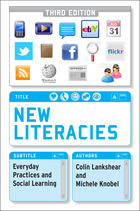Monday, November 23, 2009
New book in our series!
Enormous congrats to Margaret Hagood for her new edited collection, New Literacies Practices: Designing Literacy Learning. According to the back blurb:
New literacies have been researched with various age groups in a variety of settings, illustrating how text uses differ across contexts and highlighting stark divides between schooled and out-of-school literacies. Not surprisingly, schools have difficulty staying abreast of the technological and social aspects associated with new literacies. New Literacies Practices: designing Literacy Learning takes into account these two concerns--the dichotomy of contextual uses of new literacies across spaces, and concerns that schooled instructional attempts with new literacies reify conventional literacy practices. Authors in this volume include classroom teachers and researchers who being from a stance that in an interconnected, multimodal world, new literacies exist across spaces. It is no longer appropriate to consider if literacies between contexts, such as out-of-school and in-school, dovetail. Instead, we must shape examinations according to how they dovetail. The essays in this volume forge the amorphous divide between out-of-school and in-school literacies through a design of pedagogy and examine how teachers and researchers collaborate to design instruction that accounts for students' new literacies. This book acknowledges that new literacies must be embedded into the curriculum, not just included as an add-on course or activity to the school day.
Chapters include:
Introduction: Designing Learning with New Literacies
Margaret C. Hagood
Chapter 1: The Tupac Effect: A Case for Socially Relevant Education
Michael Bitz
Chapter 2: “We Want Some Pancakes!” Teaching for critical media literacies with Pancake Mountain
Amy Suzanne Johnson & Achariya Tanya Rezak
Chapter 3: Adolescents’ Explorations with Do-It-Yourself Media: Authoring Identity in
Out-of-School Settings
Barbara J. Guzzetti
Chapter 4: Crossing Spaces of In and Out-of-School Literacies through
Museum and Classroom Design, Production, and Consumption Practices
A. Jonathan Eakle
Chapter 5: Day of Tears: Day of Desperation: Using Blogging to Make Social Studies Content Engaging and Comprehensible
Melissa I. Venters
Chapter 6: Digital Storytelling Is Not the New Power Point:
Adolescents’ Critical Constructions of Presidential Election Issues Photo Stories
Emily N. Skinner & Melanie J. Lichtenstein
Chapter 7: Artifactual English: Transitional Objects As A Way Into English Teaching
Jennifer Rowsell
Chapter 8: New Literacies and Special Education: Current Practice and Future Promise
Mary C. Provost & Andrea M. Babkie
Chapter 9: Vignettes of Successful Middle School Teachers Who Use New Literacies
Paula E. Egelson

Tuesday, November 03, 2009
Birmingham Small Arms
The tale of the Birmingham Small Arms company is an interesting one, indeed, and throws a certain light on the perennial fascination that so many hard core bikers--especially those of the gang affinity group affiliation type--have with small (and not so small) arms.
For me, the interest has ever only been in the bikes. In the fun years between my Masters and PhD struggles I acquired 2 BSAs. One was a 150cc Bantam. The other, purchased as partially restored parts, was a BSA pre-unit construction 500cc plunger framed model dating to 1950. I reckoned that for someone who had never ridden a motorcycle, let alone rebuilt one, the BSA would be a worthy challenge. And it was.
All kinds of interesting networks came into play. Like a flatmate's fascination with a young woman across the road--affectionately referred to by Johnnie-the-Obsessed as "The Goddess"--led to Kenny, the Goddess' younger brother. Kenny had old Brit thumpers from early adolescence, and backed them ahead of study. So by the time I had acquired the BSA parts, Kenny had already been dishonorably discharged from school and would be very happy indeed to spend some days hanging out putting the bike together once I had sandblasted and spray painted various remaining parts, had the chome bits re-plated, and imported all the authentic "cycle thread" nuts and bolts I could lay my hands on via snail mail from Lewis and sons, in Weybridge, England. Boxes of beautifully plated cycle thread in different sizes would arrive in Christchurch, New Zealand from the other side of the world, paid for by my hard-earned tutoring money from Canterbury University.
The bike duly came together, and then Kenny taught me (more or less) to ride the thing. Then it had to get its "warrant of fitness" certificate. I got my licence in the morning, took my first lengthy ride -- 5 miles or so -- in the afternoon, and by evening the bike was street legal.
It became my main mode of transport in Auckland, when I went there to work at Auckland University. Too many tales to tell here, but maybe one day. My worst accident landed me in hospital for 12 months worth of stays over a couple of years, while some very skilled surgeons rebuilt a leg. By that time I had my doctorate, and lying in bed for months on end provided a perfect opportunity to turn the sucker into a book. It must have sold a copy or two in Britain, because Ivor Goodson read it and informed me of this when he visited Auckland University. Over a pint (it may have been more) of beer at the bar down the road from my office Ivor said he'd read the book (called "Freedom and Education" in the days before that struck me as oxymorinic) and he reckoned there was a paragraph in it that he rather liked. He asked what I was writing about these days, and I told him that post thesis I had got interested in Paulo Freire's concept of freedom as liberation. I was now writing about literacy and revolution.
Ivor reckoned you always needed three things in a title. So he asked "why don't you add "schooling" and write a book on "Literacy, Schooling and Revolution"? I said I had these motorbikes (a 1973 Triumph had been added to the stable by that time) and lots of mates and some spare time, and a reasonably fun life, so I didn't think that writing something that would prolly end up in some acquisition editor's trash can was a very good idea. I was happy enough writing the odd paper (and most of them *were* pretty odd). Ivor said "Oh, we'd give you a contract" and for some reason that must have made a difference.
The rest is the treadmill I am just now hopping off.
So, this week is a holiday, and I am down here in a lovely part of the world just out of Toowoomba, Australia, and this just happens to be where the old single banger hangs out these days. It's not street legal (having been imported from New Zealand and still awaiting the roadworthy check, relicensing, etc.), although I am working on that. I do, however, have a helmet, and in a quiet part of the world that is relatively lightly policed the odds are pretty good of being able to do some road testing without getting done.
So, that is some of what I've been doing. and here's the ole pal in question.








